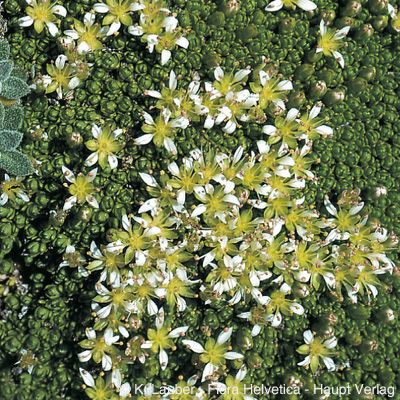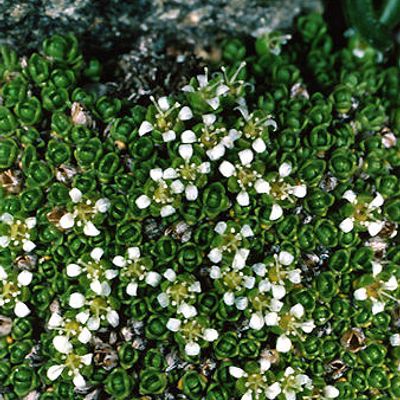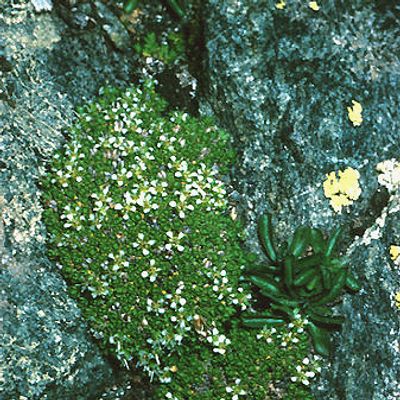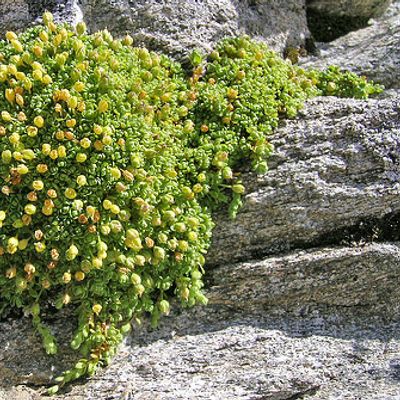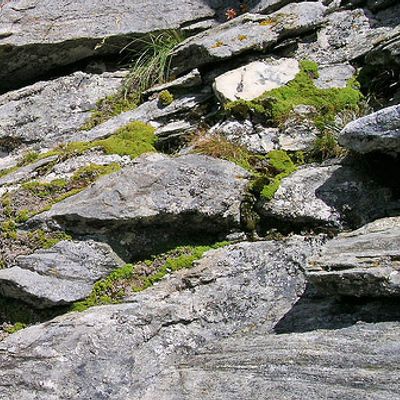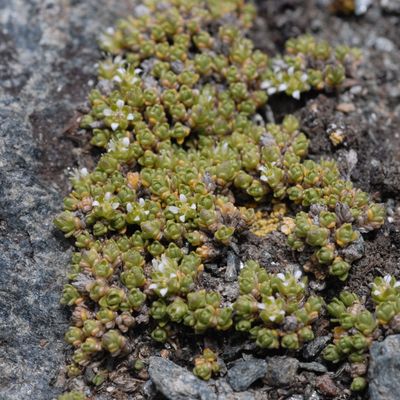Minuartia cherlerioides subsp. rionii (Gremli) Friedrich
1029120
Subspecies
ISFS : 260600
Checklist : 1029120
ISFS : 260600
Checklist : 1029120
Contains :
Synthesis
Species description (© Flora Helvetica 2018)
Dicht polsterförmig, 2-5 cm hoch. Stängel aufrecht, verzweigt, dicht dachziegelig beblättert. Blätter lanzettlich, 1-3 mm lang, stumpf, 3nervig. Blüten einzeln am Ende der Zweige auf sehr kurzen Stielen, 4zählig. Kronblätter weiss, benagelt. Kelchblätter hellgrün, spitz, 2-4 mm lang, 3nervig. Staubblätter 8 (bei den andern M.-Arten 10). Kapsel etwas länger als der Kelch. In der Schweiz nur die auf Silikat lebende subsp. rionii mit bewimperten Blättern.Flowering period (© Flora Helvetica 2018)
7-8Habitat and distribution inside Switzerland (© Flora Helvetica 2018)
Felsen und Felsschutt / alpin / VS, TIWorld distribution (© Flora Helvetica 2018)
ZentralalpinEcological indicator (© Landolt & al. 2010)
221-513.c.2n=36Status
IUCN status
VulnerableNational Priority
2 - high national priorityInternational responsibility
3 - highConservation
Threats
Touristische Erschliessungen, evtl. Militärbauten, Übungsschiessen
Isolierte Populationen
Distribution map
Habitat and distribution inside Switzerland
VS, TIWorld distribution
ZentralalpinEcology
Life form
Subfructicose chamaephyte
Habitats
Milieux Phytosuisse (© Prunier et al. 2017)
Habitats © Delarze & al. 2015
 | 3.4.2.2 - Silikatfelsflur (Androsacion vandellii) |
bold
Dominant species, influencing the appearance of the habitat
 Character species
Character species
 Less strictly linked to a specific habitat
Less strictly linked to a specific habitat
Ecological indicator values by © Landolt & al. (2010)
| Soil factors | Climatic factors | Salinity tolerance | |||
|---|---|---|---|---|---|
| Humidity Value H | -- | Light Value L | -- | Salinity Index | -- |
| Reaction Value R | -- | Temperature factor T | -- | ||
| Nutriments value N | -- | Continentality K | -- | ||
- Ecological values legend
Humidity Value H 1 very dry 1+ dry 2 moderatly dry 2+ moist 3 medium wet 3+ wet 4 very wet 4+ soggy 5 submerged or underwater f plants living in running water u mostly submerged plants v partly submerged, partly floating plants w humidity moderately variable (± scale of 1-2) w+ highly variable humidity (scale exceeding ± 2) Reaction Value R 1 Very acid (pH 2.5-5.5) 2 acid (pH 3.5-6.5) 3 lightly acid to neutral (pH 4.5-7.5) 4 neutral to basic (pH 5.5-8.5) 5 basic (pH 6-5 -> 8.5 Nutriments value N 1 very low in nutrients 2 low in nutriments 3 medium-poor to medium-rich in nutrients 4 rich in nutriments 5 very rich in nutriments Salinity tolerance 1 halotolerant 3 halophyle Light Value L 1 very shady 2 shady 3 lighted areas 4 luminous 5 highly luminous Temperature factor T 1 alpine to nival stages (from the treeline to the snowline) 1+ suprasubalpine and upper subalpine levels (pine and larch forests) 2 subalpine level (coniferous forests without beeches up to the upper limit of spruces) 2+ lower subalpine and upper mountain stages 3 mountain level (beech and silver fir forests, in the central Alps Scots pine forests) 3+ lower mountain and upper hill levels 4 hill level (mixed deciduous oak forests) 4+ hot places, hill level 5 very hot places, hill level (only in the hottest places, typical of southern Europe) Continentality K 1 Atlantic (high air humidity, very low temperature variations, mild winters) 2 Sub-Atlantic (high air humidity, low temperature variations, relatively mild winters) 3 sub-Atlantic to subcontinental (average air humidity, moderately variable temperature, slightly low winter temperatures) 4 subcontinental (low air humidity, large temperature variations, rather cold winters) 5 continental (very low air humidity, very large temperature variations, cold winters)
Water dependency
| Rivers | 0 - No link |
| Calm water | 0 - No link |
| Ground water | 0 - No link |
Nomenclature
Accepted Name (Checklist 2017)
Minuartia cherlerioides subsp. rionii(Gremli) Friedrich
Vernacular name
Deutscher Name :
Mannsschild-MiereNom français :
Minuartie coussinetNome italiano :
Minuartia a otto stamiMatch with other reference books
| Relation | Nom | Book | No |
|---|---|---|---|
| = | Minuartia cherlerioides subsp. rionii (Gremli) Friedrich | Checklist 2017 | 260600 |
| = | Minuartia cherlerioides subsp. rionii (Gremli) Friedrich | Flora Helvetica 2001 | 325 |
| = | Minuartia cherlerioides subsp. rionii (Gremli) Friedrich | Flora Helvetica 2012 | 1161 |
| = | Minuartia cherlerioides subsp. rionii (Gremli) Friedrich | Flora Helvetica 2018 | 1161 |
| = | Minuartia cherlerioides subsp. rionii (Gremli) Friedrich | Index synonymique 1996 | 260600 |
| = | Minuartia cherlerioides subsp. rionii (Gremli) Friedrich | SISF/ISFS 2 | 260600 |
| = | Minuartia cherlerioides subsp. rionii (Gremli) Friedrich | Welten & Sutter 1982 | 246 |
= The taxon corresponds to the accepted taxon (Checklist 2017)
< The taxon is included in the accepted taxon (Checklist 2017)
> The taxon includes (among others) also the accepted taxon (Checklist 2017)
< The taxon is included in the accepted taxon (Checklist 2017)
> The taxon includes (among others) also the accepted taxon (Checklist 2017)
Status
Native status
-IUCN list of endangered species (© Walter & Gillett 1997) : Yes
Status on national Red List 2016
IUCN status:
Vulnerable

Additional information
IUCN criteria: C1; C2a(i)
Status on regional Red List 2019
| Biogregraphic regions | Status | IUCN criteria |
|---|
- Legend
EX Extinct RE Regionally Extinct CR(PE) Critically Endangered, Probably Extinct CR Critically Endangered EN Endangered VU Vulnerable NT Near Threatened LC Least Concern DD Data Deficient NE Not Evaluated NA Not Applicable
National Priority Species List Status
| National Priority | 2 - high national priority |
| Need to take action | 1 - |
| International responsibility | 3 - high |
| Need to monitor populations | 1 - |
Protection status
| International (Bern Convention) | No | |
| TI | total protection | (23.01.2013) |
| Switzerland | -- |
- Disclaimer
InfoFlora compiles information on protected species as accurately as possible, taking it from the respective cantonal laws. In some cases, however, it was not possible to use the plant names as listed in the original text, but an interpretation of their taxonomy or nomenclature was necessary. The exact meaning of the categories „completely protected“ and „partially protected“ differs among the cantons.
InfoFlora cannot guarantee that the information on the protection status is correct and complete. In case of doubts, we recommend to look up the texts of the respective cantonal law.
Status by sector of activity
| Agriculture-related environmental objectives : | more informations | |
| Forest management environmental objectives : | more informations |
Conservation
Threats and measures
Touristische Erschliessungen, evtl. Militärbauten, Übungsschiessen
Keine neuen Seilbahnen, Pisten und Infrastrukturbauten
Schuttfelder mit Vorkommen nicht beeinträchtigen
keine Zielgebiete bei bekannten Vorkommen
Isolierte Populationen
Schutz aller Fundstellen (z.B. mit Mikroreservaten)
Bestandeskontrollen ca. alle 10 Jahre
